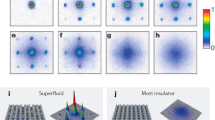Abstract
We consider the influence of the control and probe beams in the electromagnetically induced transparency configuration on the mechanical motion of ultracold atomic gases (atomic Bose-Einstein condensates or degenerate Fermi gases). We carry out a microscopic analysis of the interplay between radiation and matter and show that the two beams of light can provide an effective magnetic field acting on electrically neutral atoms in the case where the probe beam has an orbital angular momentum. As an example, we demonstrate how a Meissner-like effect can be created in an atomic Bose-Einstein condensate.
Similar content being viewed by others
References
L. Pitaevskii and S. Stringari, Bose-Einstein Condensation (Clarendon Press, Oxford, 2003).
U. Leonhardt, T. Kiss, and P. Öhberg, Phys. Rev. A 67, 033602 (2003).
B. DeMarco and D. Jin, Science 285, 1703 (1999).
Z. Hadzibabic, S. Gupta, C. Stan, et al., Phys. Rev. Lett. 91, 160 401 (2003).
D. Tilley and J. Tilley, Superfluidity and Superconductivity (Inst. of Physics, Bristol, 1990).
G. Juzeliunas and P. Öhberg, Phys. Rev. Lett. 93, 033602 (2004).
L. V. Hau, S. E. Harris, Z. Dutton, and C. Behrooz, Nature 397, 594 (1999).
M. Kash, V. A. Sautenkov, A. S. Zibrov, et al., Phys. Rev. Lett. 82, 5229 (1999).
D. Budker, D. Kimball, S. Rochester, and V. Yashuk, Phys. Rev. Lett. 83, 1767 (1999).
U. Leonhardt and P. Piwnicki, Phys. Rev. Lett. 84, 822 (2000).
M. Artoni and I. Carusotto, Phys. Rev. A 67, 011602 (2003).
G. Juzeliunas, M. Maíalas, and M. Fleischhauer, Phys. Rev. A 67, 023809 (2003).
M. Fleischhauer and M. Lukin, Phys. Rev. Lett. 84, 5094 (2000).
C. Liu, Z. Dutton, C. Behroozi, and L. V. Hau, Nature 409, 490 (2001).
D. Phillips, A. Fleischhauer, A. Mair, et al., Phys. Rev. Lett. 86, 783 (2001).
L. Allen, M. Padgett, and M. Babiker, Prog. Opt. 39, 291 (1999).
L. Allen, S. M. Barnett, and M. J. Padgett, Optical Angular Momentum (Inst. of Physics, Bristol, 2003).
E. Arimondo, Prog. Opt. 35, 259 (1996).
S. Harris, Phys. Today 50, 36 (1997).
A. B. Matsko, O. Kocharovskaja, Y. Rostovtsev, et al., Adv. At., Mol., Opt. Phys. 46, 191 (2001).
M. Lukin, Rev. Mod. Phys. 75, 457 (2003).
D. Butts and D. Rokshar, Phys. Rev. A 55, 4346 (1997).
M.-O. Mewes, D. Ferrari, F. Schreck, et al., Phys. Rev. A 61, 011403 (2000).
G. Juzeliunas and M. Masalas, Phys. Rev. A 63, 061602 (2001).
M. Babiker, C. Bennett, D. Andrews, and L. D. Romero, Phys. Rev. Lett. 89, 143601 (2002).
J. Arlt, K. Dholakia, J. Soneson, and E. M. Wright, Phys. Rev. A 63, 063602 (2001).
E. M. Wright, J. Arlt, and K. Dholakia, Phys. Rev. A 63, 013608 (2001).
J. Leach, E. Yao, and M. Padgett, New J. Phys. 6, 71 (2004).
C. J. Pethick and H. Smith, Bose-Einstein Condensation in Dilute Gases (Cambridge Univ. Press, Cambridge, 2002).
Y. Shin, M. Saba, M. Vengalattore, et al., cond-mat/0407045 (2004).
C. Garvie, E. Riis, and A. S. Arnold, Laser Spectroscopy XVIP, Ed. by Hannaford et al. (World Scientifc, Singapore, 2004).
C. Regal, M. Greiner, and D. Jin, Phys. Rev. Lett. 92, 040 403 (2004).
D. McGloin, G. Spalding, H. Melville, et al., Opt. Express 11, 158 (2003).
P. Öhberg, Phys. Rev. A 66, 021603 (2002).
Author information
Authors and Affiliations
Additional information
From Optika i Spektroskopiya, Vol. 99, No. 3, 2005, pp. 375–379.
Original English Text Copyright © 2005 by Juzeliunas, Öhberg.
The text was submitted by the authors in English.
Rights and permissions
About this article
Cite this article
Juzeliunas, G., Öhberg, P. Creation of an effective magnetic field in ultracold atomic gases using electromagnetically induced transparency. Opt. Spectrosc. 99, 357–361 (2005). https://doi.org/10.1134/1.2055927
Received:
Issue Date:
DOI: https://doi.org/10.1134/1.2055927




